12 Recycling Facts: Statistics to Know in 2025
-
Pete Ortiz
- Last updated:
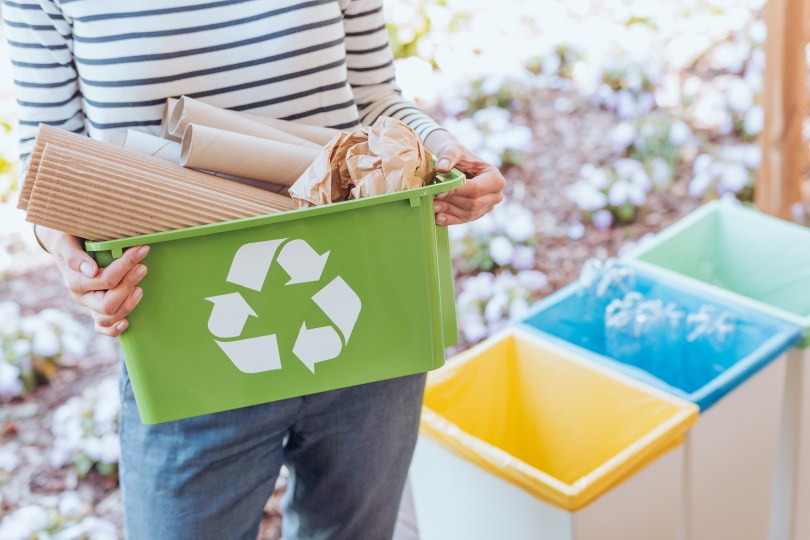
Note: This article’s statistics come from third-party sources and do not represent the opinions of this website.
We all know the benefits of recycling. There’s a feeling of responsibility we get from saving the environment. Or, maybe it’s just a matter of economics and convenience. But are there facts and statistics behind recycling?
Recycling is great in several aspects. But have you ever wondered how much better it could get? The fact is, each time we recycle something, we’re saving energy and resources that would’ve been used to produce something new. It also contributes to a country’s GDP besides reducing our carbon footprint. People are employed to collect, sort, and transport materials.
When you recycle, you are helping the environment. You are reducing pollution and conserving our natural resources. Recycling is not only good for the environment, but it’s also good for the economy.
Click below to jump ahead:
- Paper Recycling Facts
- Glass Recycling Facts
- Facts about Recycling Glass Bags
- General Recycling Facts and Statistics
Top 12 Recycling Facts and Statistics
- Every ton of recycled paper preserves 17 trees.
- About 46 million tons of paper and paperboard are recycled annually in the US.
- Recycling old paper to produce new paper consumes between 30% and 50% less energy compared to producing paper from trees.
- A modern glass bottle would take more than 4000 years to decompose when it’s in the landfill.
- Every year, Americans dispose of around ten million metric tons of glass. Only 33% of it gets recycled.
- Glass can be recycled more frequently than other items without losing its quality.
- Recycled glass bags are a great way to add visual interest to your garden.
- Recycled glass bags can replace the non-renewable resin in plastic bags.
- The most challenging recyclable waste is multi-material plastic packaging.
- 38% of global waste comprises dry recyclables such as metal, paper, and plastic. Only about 13.5% of them are recycled.
- Every year, 69.1 million tons of municipal solid waste is recycled in the US.
- Recycling one ton of plastic can save up to 2000 gallons of gasoline.
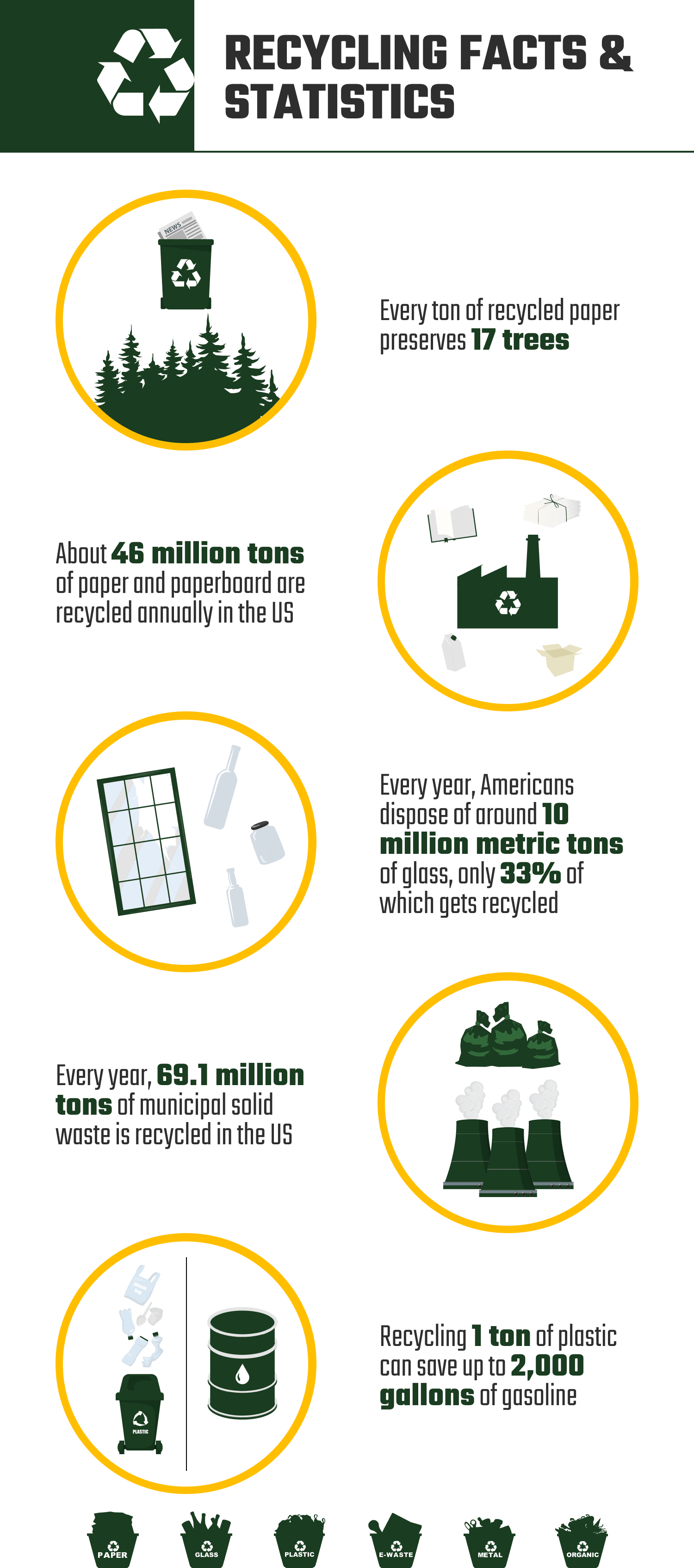
Paper Recycling Facts
1. Every ton of recycled paper preserves 17 trees.
(USI)
It’s easy to forget that old newspapers and magazines aren’t just trash. Recycling them helps minimize the number of trees that need to be cut down to produce new paper.
Paper recycling is an excellent way to reduce your environmental impact. It prevents the release of toxic chemicals into the air and water.
Every time you recycle a pound of paper, you are protecting your health and the planet. Paper is a renewable resource, but it takes a lot of energy and water to make new paper from old. So, recycling helps conserve natural resources.
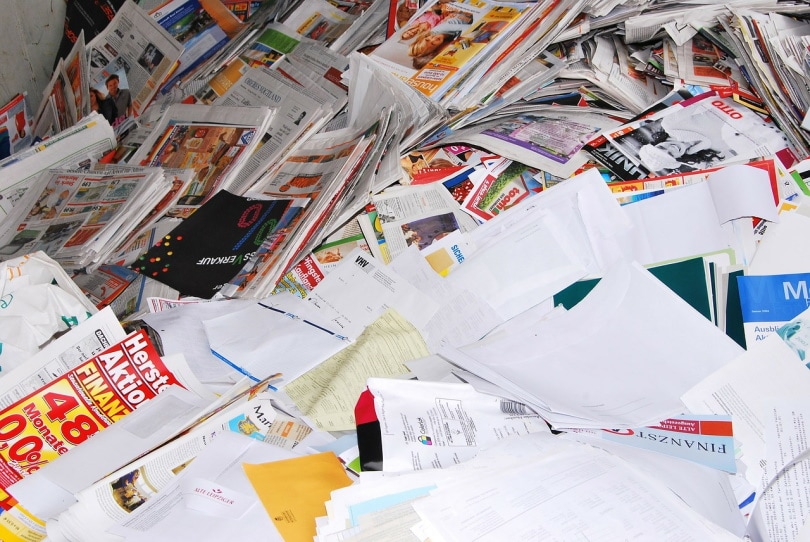
2. About 46 million tons of paper and paperboard are recycled annually in the US.
(EPA)
Paper recycling is the process of converting used paper into new usable products. It’s beneficial because it conserves natural resources, reduces pollution, and saves energy.
The US recycles over 46 million tons of paper every year. A large portion of it ends up as pulp for the manufacture of new paper products, such as toilet papers, tissues, or other packaging materials.
Besides providing one-time use products like these, recycling also reduces pressure on the forests. It’s because more material from print media replaces trees in all sorts of other everyday objects such as grocery bags and disposable.
3. Recycling old paper to produce new paper consumes between 28% and 70% less energy compared to manufacturing paper from trees.
(SCIENCE DIRECT)
It takes less energy to recycle paper than to produce it from trees. That’s because the manufacturing process involves a great deal of heating. But recycling requires much less heat than making virgin pulp. The amount of energy saved depends on the process used and the type of material recycled.
Thus, when you choose recycled paper, you are helping to preserve our natural resources. Recycled paper products do not use trees. Instead, they rely on waste paper that would otherwise end up in landfills or as litter on streets and sidewalks.
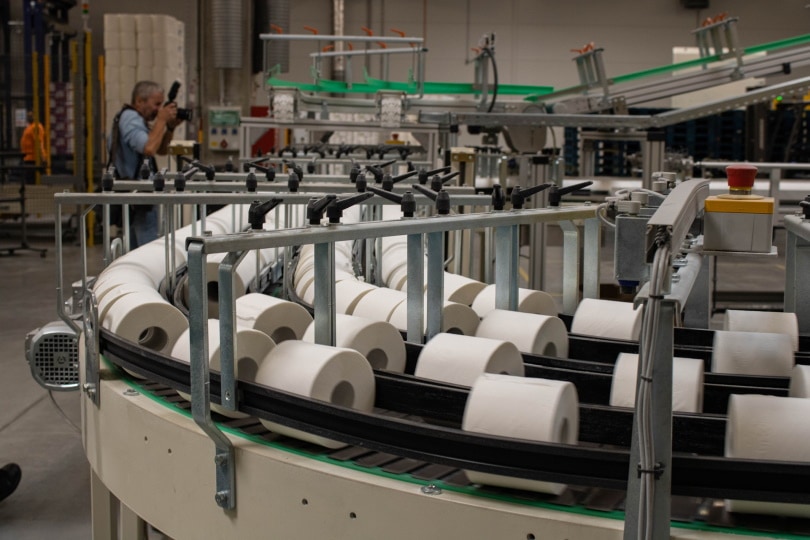
Glass Recycling Facts
4. A modern glass bottle would take more than 4000 years to decompose when it’s in the landfill.
(USI)
Glass is non-biodegradable. It is made of silica and sand, elements that can take thousands of years to decompose when it’s in the landfill. Another reason it takes so long is the thickness. Glass is thicker than plastic. It makes it harder for microorganisms to break it down.
5. Every year, Americans dispose of around ten million metric tons of glass. Only 33% of it gets recycled.
(CEN)
Glass has three main components: sand (usually silica), soda ash (sodium carbonate), and limestone. Sand and limestone are naturally occurring substances.
The soda ash is manufactured in a chemical process. All three ingredients are melted together at high temperatures to create molten glass. Then, it goes through several cooling stages before it’s ready to be used.
Only a small portion is recycled of all the glass Americans dispose of. The problem is that glass is heavy and expensive to transport. So, recycling isn’t always economically feasible.
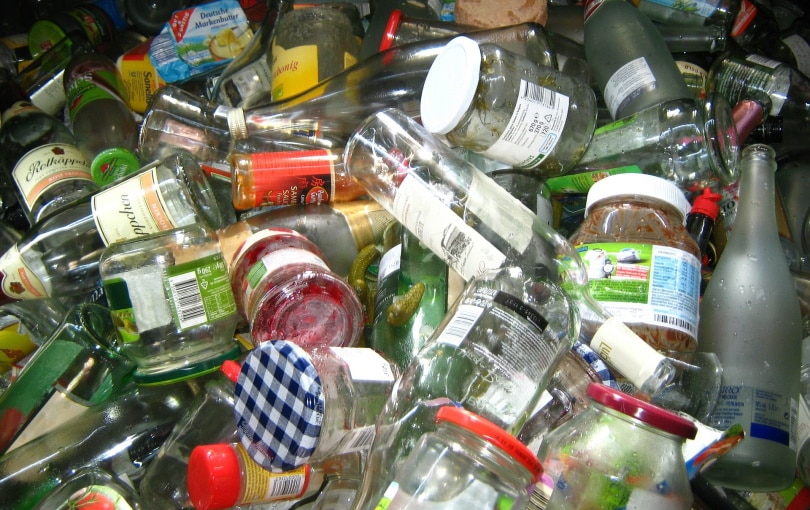
6. Glass can be recycled more frequently than other items without losing its quality.
(GPI)
Glass maintains its quality despite recycling frequently. It’s because it can withstand heat and pressure. After being melted down into a liquid glass, it can be poured into molds and cooled into various shapes again.
When you recycle glass, you save natural resources. Also, you end up with new glass items at a reduced cost of raw materials.
More importantly, there is less pollution if you are recycling as opposed to initial production from the glass manufacturing plants.
Facts about Recycling Glass Bags
7. Recycled glass bags are a great way to add visual interest to your garden.
(INSTALL IT DIRECT)
Recycled glass bags for planting flowers can be quite visually appealing in any garden. The translucent glass lets light through, which makes plants grow faster. The bags also protect plants from frost and cold winds.
Glass bags can be used in a variety of ways in the garden. They can be placed at the base of trees, around bushes, or even on top of flower beds. The color and texture they add to your yard will make it stand out from other yards in the neighborhood.
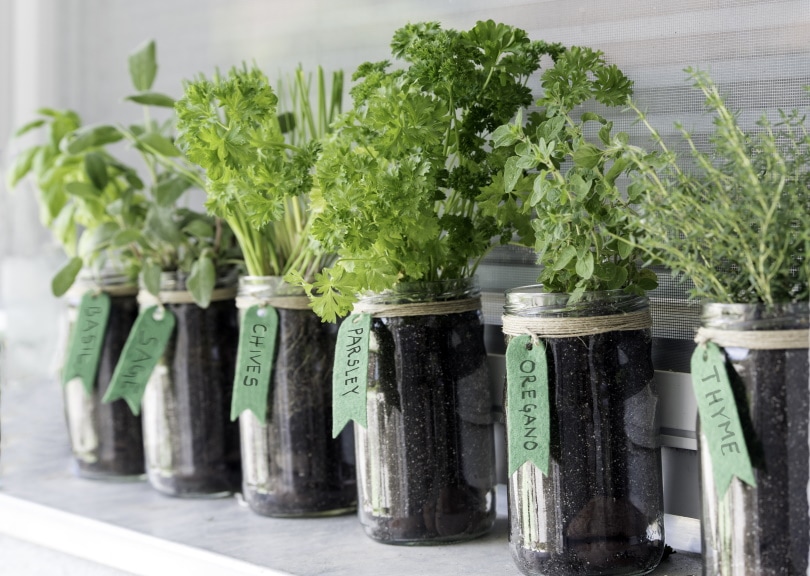
8. Recycled glass bags can replace the non-renewable resin in plastic bags.
(21 OAK)
There are alternatives you can use to protect the environment. They include glass bags that don’t contribute to pollution or littering.
Glass is a natural material that can be recycled without losing strength. Many people are aware of the environmental benefits of recycling glass. By switching from plastic to glass, you are helping to eliminate trash while keeping your food fresh!
General Recycling Facts and Statistics
9. The most challenging recyclable waste is multi-material plastic packaging.
(RESEARCH GATE)
Recycling multi-material plastic packaging is challenging. It’s because each type of plastic has its processing requirements. Getting them mixed up means they’ll likely end up in the landfill instead of being recycled.
Multi-material plastics need to be separated into their respective materials to be recycled. But the sorting technology needed wasn’t available until recently.
Many items that contain plastic, such as food and beverage containers, have many layers of plastic. As the number of layers increases, the material gets more difficult to recycle because each layer must be separated from the others, which is not easy.
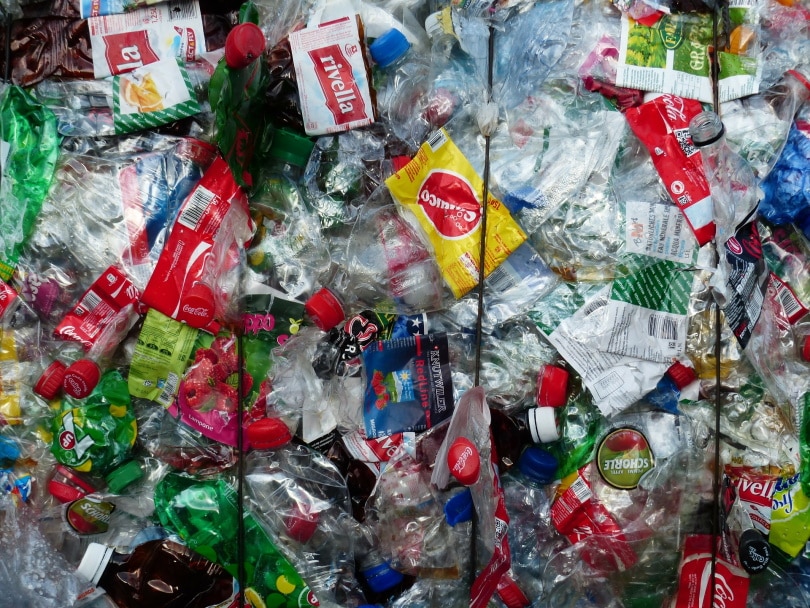
10. 38% of global waste comprises dry recyclables such as metal, paper, and plastic. Only about 13.5% of them are recycled.
(CNBC)
Even though dry recyclables make up a third of the total waste globally, most of it is thrown away as part of the trash. Most people don’t realize that they can recycle these items, especially if they are still in good condition.
Dry recyclables are materials such as paper, plastic, glass, aluminum, steel, and tin cans. Recycling these items helps prevent more waste by creating new materials from old ones. The new materials are often used in other products. So, there’s no need to create new ones from scratch.
11. Every year, 69.1 million tons of municipal solid waste is recycled in the US.
(STATISTA)
The recycling of solid waste is a practice used to reduce the amount of waste produced by reusing or recycling the materials. It reduces the consumption of fresh raw materials, such as iron, aluminum, and plastic. It also reduces energy usage and air pollution (from incineration) by reducing the need for “conventional” waste disposal.
The US produces municipal solid waste in millions annually.
The most obvious action you can take is to recycle whenever possible and buy recycled goods instead of new ones. If everyone did these two things, we’d reduce our contribution to landfills and help keep more recyclables out of our oceans and waterways!
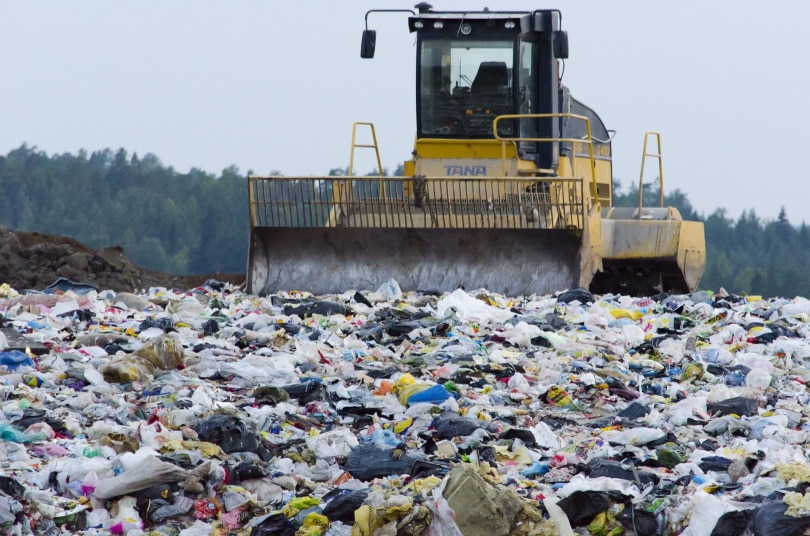
12. Recycling one ton of plastic can save up to 2000 gallons of gasoline.
(WASTE WISE PRODUCTS)
In recent years, the increased demand for plastics has led to higher consumption of petroleum products. Over 30 million gallons of oil are used in the manufacture of plastic each year. That’s why it’s crucial to recycle as much plastic as possible and use it to make more plastic.
The more we recycle and reuse the same plastic material, the less oil will be required to produce additional plastic. It takes a lot of energy to make plastic from petroleum products. But recycling reduces the need for new plastic.
Frequently Asked Questions on Recycling
What item is recycled often worldwide?
Paper is the most recycled waste product worldwide. Other recycled items often include plastic, metal, glass, and food products.
Globalization has raised awareness about the environment, and more people see the need to recycle items. They realize that pollution is a global problem.
Tossing an item in the recycling bin seems like a small gesture. But it can have a massive impact on the environment. Recycling is one of the easiest ways to become greener and to help reduce pollution.
(EPA)
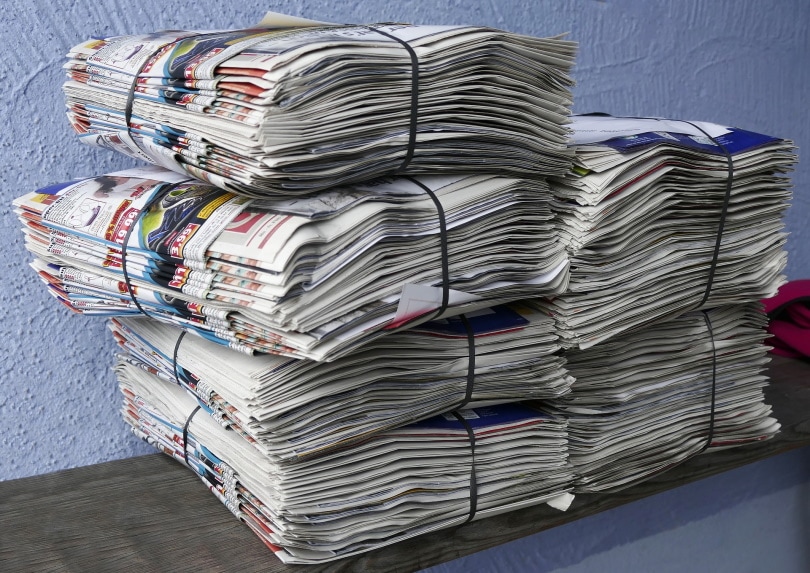
How does recycling conserve energy?
When you recycle, you’re keeping products out of the waste stream and stopping new manufactures. This process uses up natural resources that would be used to create new products.
Recycling saves the amount of energy that would be used to create a new product.
Currently, almost all recycled materials are turned into new products or reused somehow. Aluminum is smelted from recycled cans and turned into new cans. A new paper is made from old paper.
(AMERICAN GEO SCIENCES)
What happens to items that aren’t recyclable?
In many cases, items that cannot be recycled end up in landfills. It can be an environmental hazard depending on the chemicals the products contain. For instance, many non-recyclable items such as electronics contain hazardous materials.
Non-recyclable food containers, glass jars, and plastic containers can be messy too. They can contaminate other recyclables. These contaminants make it harder for facilities to do their jobs, just like with plastic bags and film.
(HAWAII ZERO WASTE)
Can you put everything in a single recycling bin?
It depends on where you live. For example, in Canada, there are rules. They use “single-stream” collection systems. Here, all recyclables are mixed and sorted later. It’s a controversial process because it can lead to contamination and the loss of valuable resources.
The problem with this collection system is that it makes it harder to collect the recycling materials. For instance, if there is no way to avoid contamination from food waste, the paper must be processed at higher temperatures. It’s done to kill the bacteria.
This way, more energy is used, and more pollution is created. And, if one type of plastic gets mixed in with other types of plastic, the quality of recycled plastic will be lower.
(GRIST)
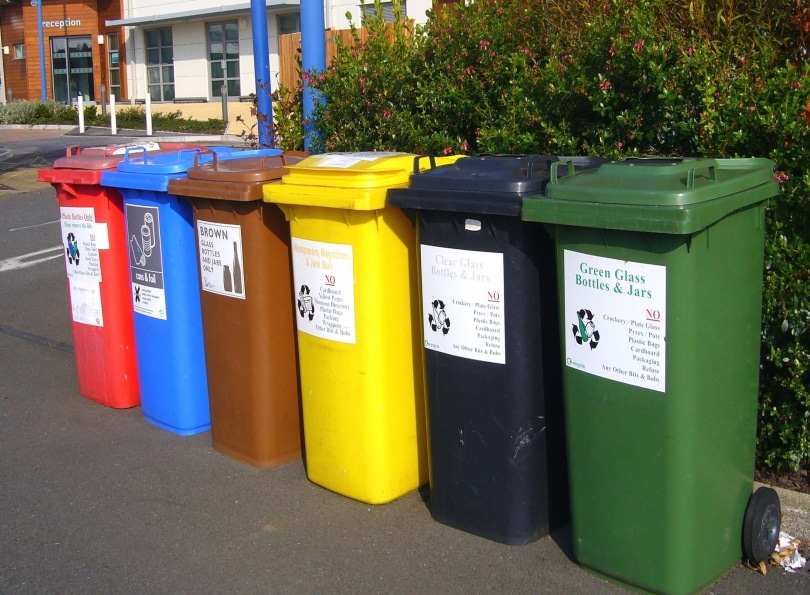
What are the four recycling types?
One type is paper recycling. There are two ways of recycling paper: the pulping and the mechanical method. Pulping uses chemicals that break down the fibers and shreds of paper. This way, they can be mixed with water or another substance and then turned into recycled paper pulp. Mechanical methods use machines to turn paper into pulp. The pulp can be used to process new cardboard boxes or toilet paper.
Also, glass can be recycled over and over again without losing any quality of strength or purity. It must first be crushed into small pieces callis ed cullets. It gets the glass ready for recycling. The cullet is washed, dried, and melted down into a liquid form. After that, it’s cooled, re-heated, and then pressed into a mold to create new glass bottles or jars.
Another type of recycling is metal recycling. Metals are a group of elements that are found in the earth’s crust. They have many uses. Some metals such as iron and aluminum are valuable on their own. Other metals such as copper must be recycled before you can reuse them.
Textiles can also be recycled. When you recycle your textiles, you’re protecting the environment. Every year, textile waste ends up in landfills and incinerators. Some of it is recycled, but not enough. It’s crucial to sort these correctly so they can be recycled well.
(ISM WASTE)
What type of technology is used when recycling?
A new system called HydroPRS uses hydrocyclone technology when recycling plastic waste material. Hydrocyclones are high-speed water-based centrifuges. They can remove contaminants from recyclable materials. Then, they clean them for further processing into new products.
Hydrocyclones have been used for decades in the pulp and paper industries. Recently, they have been adapted for plastic recycling.
HydroPRS is the world’s leading provider of integrated software and services for recycling. It focuses on waste management, energy from waste, and industrial recycling.
(CIRCULAR ONLINE)
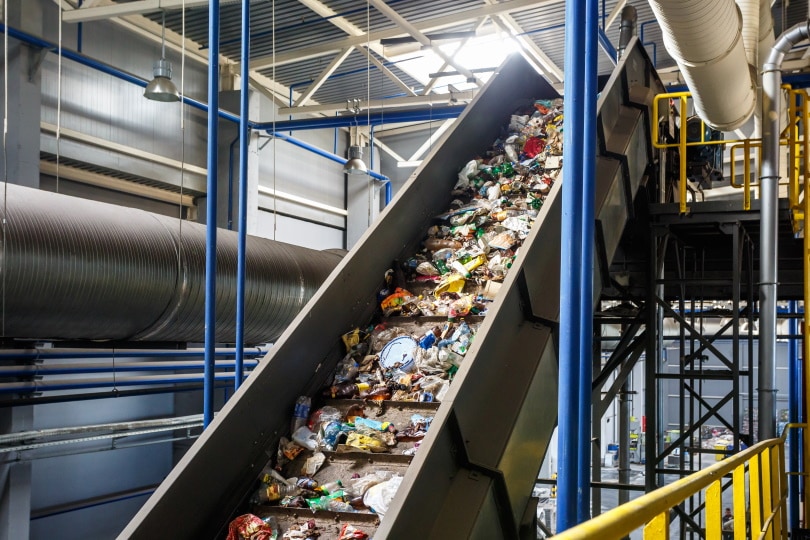
Why aren’t paper towels, tissues, and napkins accepted for recycling?
Paper towels, tissues, and napkins are not recyclable. It’s because they are made using already recycled paper. They contain similar materials with different levels of purity.
Some are made from old newspaper stock that has been recycled several times. Others may contain food products or other contaminants from the manufacturing process.
The fibers in recycled paper are broken down many times and cannot be recycled or reused again.
(RECYCLE RIGHT)
Benefits of Recycling
The recycling process reduces carbon emissions since less energy is required in manufacturing. Also, it cuts down on the emission of greenhouse gases such as carbon dioxide (CO2), which is usually generated during the incineration process.
Additionally, recycling keeps garbage out of landfills, one of the biggest benefits of recycling! The more we recycle, the less garbage we produce. Also, the more space there will be in landfills for future generations to use as well.
Recycling reduces energy costs. You can take recycled products and transform them into new products. This way, you aren’t using as much energy as if you had manufactured brand new products from scratch.
Recycling also creates business opportunities for entrepreneurs. If you’re looking for a way to start your own business on a budget, consider getting into recycling! There are lots of businesses that revolve around taking in used goods and transforming them into new products.
•You might also like: HOW TO GET RID OF GARBAGE DISPOSAL SMELLS (5 EASY METHODS)
•You might also like: ARE PAPER PLATES RECYCLABLE? HOW DO YOU PROPERLY DISPOSE OF THEM?

Conclusion
Recycling is about turning “discards” into new products. You can do it even at home. It has always been about reducing the demand for new products and conserving natural resources.
The above recycling facts and statistics paint a clear picture of why we need to recycle more. Cutting back on trash production will help you live healthier and reduce your carbon footprint.
Whenever possible, try to recycle as this helps the environment and your country’s economy. Also, you’ll be putting into use valuable resources that would otherwise go to waste.
See Also: Are Paper Bags Recyclable? How Do You Properly Dispose of Them?
Featured Image Credit: Photographee.eu, Shutterstock
Contents


